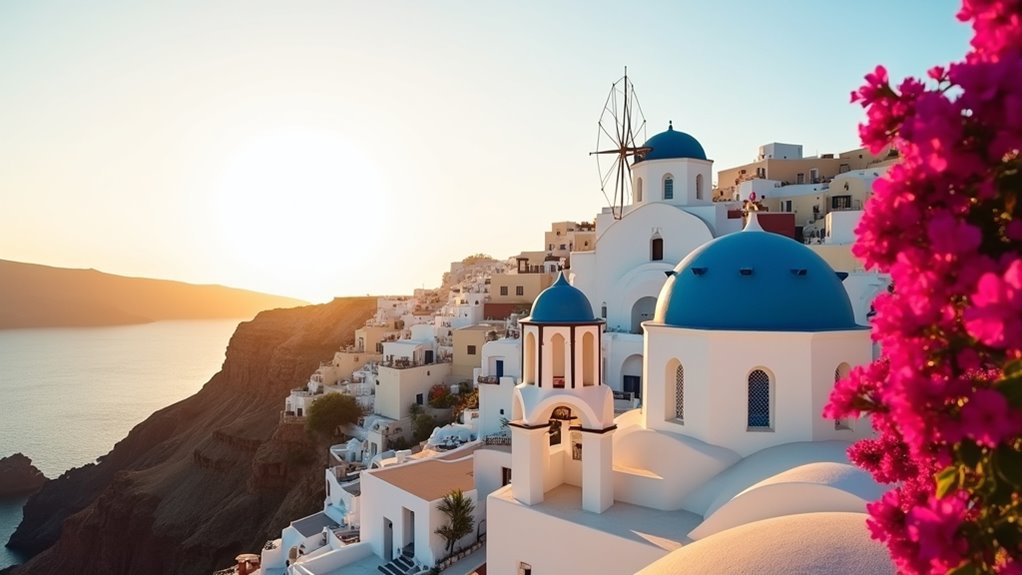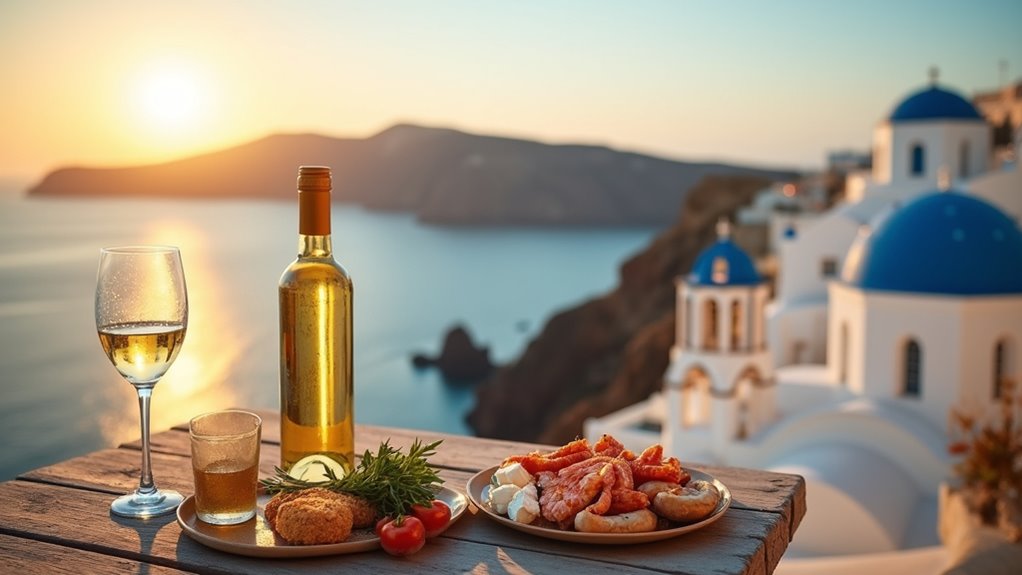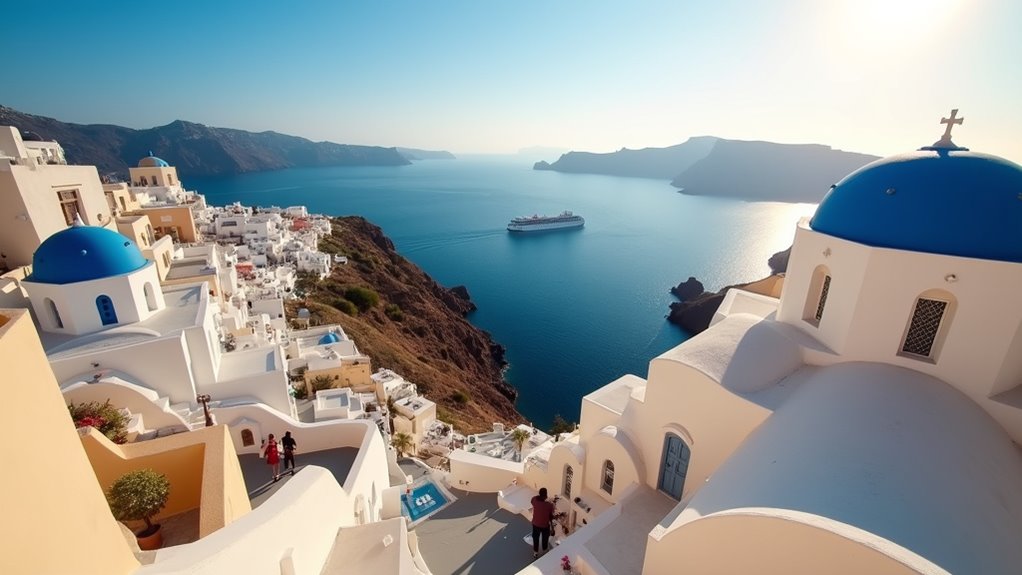Physical Address
304 North Cardinal St.
Dorchester Center, MA 02124
Physical Address
304 North Cardinal St.
Dorchester Center, MA 02124

Journey through Greece's island dilemma: will Santorini's breathtaking caldera views or Rhodes' ancient knights' tales capture your wanderlust?
You’re faced with a classic Greek island dilemma. Santorini calls with its jaw-dropping caldera views and whitewashed villages perched dramatically on volcanic cliffs. Rhodes counters with medieval streets where knights once walked and ancient ruins that whisper stories of civilizations past. Both offer stunning beaches and Mediterranean charm, but with entirely different personalities. Your perfect Greek getaway hinges on one question: do you crave postcard-perfect vistas or a journey through living history?

When comparing the origins of Santorini and Rhodes, you’ll find two dramatically different genesis stories that have shaped their unique identities. Santorini emerged from cataclysm—the powerful Minoan eruption around 1600 BCE carved out its iconic caldera and dramatic cliff faces. This volcanic activity continues to define the island, with eruptions as recently as the 1920s. The massive eruption ejected approximately 28–41 km³ of dense-rock equivalent material, transforming the landscape completely.
Rhodes, conversely, owes its character to human influence rather than geological forces. The Knights of the Order of St. John ruled from 1309 to 1522, constructing the impressive Palace of the Grand Master and fortified structures that dominate the landscape today. Both islands are charming alternatives to must-visit Athens, which offers its own unique historical allure.
Unlike Santorini’s volcanic terrain, Rhodes features typical Mediterranean geography enhanced by layers of Greek, Roman, and medieval architectural influence.
The geological differences that forged these islands extend dramatically to their coastlines, creating two distinctly different beach experiences.
Nature’s artistry reveals itself most clearly in the shorelines that define each island’s unique character.
In Santorini, you’ll discover dramatic black volcanic beaches like Perissa and Kamari, with fewer watersports but unique scenery. The Red Beach offers striking color contrasts against the blue Aegean, though reaching it requires a short hike.
Rhodes delivers variety with golden shores and extensive watersports opportunities. Prasonisi Beach attracts windsurfers and kiteboarders, while Anthony Quinn Bay provides excellent snorkeling. The island is well-known for its crystal waters and numerous swimming spots.
With more developed beach facilities and restaurant options, Rhodes caters well to families and activity seekers. For travelers seeking an alternative to both islands, Crete’s coastline offers some of the Mediterranean’s most pristine beaches with a perfect balance of natural beauty and amenities.
Your preference depends on priorities: Santorini’s beaches complement its famous caldera views, while Rhodes offers more traditional beach activities with better infrastructure and diverse coastal landscapes.

Gastronomy forms a crucial aspect of any Greek island experience, with Santorini and Rhodes offering distinctly different culinary journeys that reflect their unique histories and terrains.
In Santorini, you’ll discover world-renowned Assyrtiko wines shaped by volcanic soil, producing full-bodied whites with high acidity and mineral notes. Local winemakers use the traditional koulara system to protect their vines from strong winds while preserving moisture. The island’s traditional cuisine features fresh seafood and local produce like white eggplant, all influenced by the volcanic environment. Despite decreasing production due to climate challenges, nearly two million bottles of PDO wine are produced annually.
Rhodes presents a contrasting experience with medieval-inspired feasts influenced by the Knights Hospitaller. Here, European flavors blend with Greek traditions in dishes like stuffed grape leaves and moussaka, utilizing local olives, tomatoes, and fresh fish. Families visiting Rhodes can enjoy kid-friendly resorts that often feature special culinary programs introducing children to traditional Greek cuisine.
These dishes are often served in historically-themed dining experiences that emphasize community and shared tables, creating a unique cultural atmosphere.
For passionate photographers seeking breathtaking imagery, Santorini and Rhodes offer distinctly contrasting visual treasures that cater to different artistic sensibilities.
Santorini’s dramatic caldera, measuring 12 km by 7 km with steep cliffs, presents unparalleled aerial compositions and iconic sunset opportunities. You’ll capture the world’s only inhabited caldera, with white-washed villages clinging to volcanic formations creating stunning textural contrasts. The caldera’s impressive depth reaches 385 meters, creating dramatic shadows and light play that photographers find irresistible. Unlike the more vibrant party scenes found in Cycladic islands like Ios and Mykonos, Santorini offers a more contemplative photographic experience.
Rhodes, however, invites your lens to document centuries of history through its UNESCO-protected medieval architecture. The ancient citadel and Palace of the Grand Master offer compelling structural subjects against varied landscapes.
Your photography preferences will dictate your choice: Santorini excels in natural drama with its volcanic seascapes and blue-domed churches, while Rhodes delivers opulent historical narratives through its well-preserved fortifications and archaeological sites.

Beyond capturing breathtaking photos, your enjoyment of either island will considerably depend on how you handle crowds during your visit. Santorini’s limited space means stricter crowd management, with scheduling for cruise ships and temporary restrictions at popular sites like the Old Port of Fira until May 2025.
Meanwhile, Rhodes offers more breathing room, having successfully managed visitor flow even after the 2023 wildfires. Recent data shows Rhodes experiencing a 9% increase in pre-bookings for 2025, while Santorini continues to face challenges due to recent seismic activity. For travelers seeking fewer crowds and stunning coastal scenery, Lefkada is worth considering as an alternative Greek island destination.
Choosing where to stay dramatically shapes your Greek island experience, with Santorini and Rhodes offering distinctly different accommodation styles that reflect each island’s unique character.
In Santorini, you’ll find cave houses carved into volcanic cliffs, providing natural temperature control and breathtaking caldera views. These once-humble dwellings have been transformed into luxury retreats ideal for romantic getaways. Originally known as yposkafa, these structures were built by impoverished seafarers who couldn’t afford the hilltop homes.
Rhodes counters with historic mansions in its medieval Old Town, where Gothic, Ottoman, and Italian architectural influences merge. These well-preserved buildings combine authentic culture with modern comforts while placing you steps from major historical sites.
After a day of exploration, both islands offer vibrant evening entertainment, though Santorini’s nightlife is more subdued compared to Mykonos Town with its world-famous club scene.
Your choice ultimately depends on priorities: Santorini’s cave houses deliver serene, natural luxury perfect for couples, while Rhodes’ mansions immerse you in living history with central accessibility—often at different price points depending on season.

While both islands offer magnificent vacation potential, crafting your perfect itinerary depends entirely on your personal travel style and priorities. Choose Santorini for romantic getaways with its caldera views, sunset dining experiences, and volcanic beaches—perfect for couples seeking intimate moments in dramatic settings. If you’re planning to combine your island trip with mainland exploration, Athens provides must-see historical sites within day-trip distance of ferry connections to the islands.
Rhodes appeals to history buffs and families with its expansive UNESCO Old Town, diverse beaches, and spread-out attractions requiring vehicle rental. The island provides an enriching experience with its mythological significance and numerous archaeological sites.
Like choosing between Odysseus’s adventure and Icarus’s flight, your Greek island decision hinges on personal desire. Santorini’s breathtaking caldera views come with premium prices, while Rhodes offers more budget-friendly options with its affluent history. You’ll find your perfect Greek experience whether you’re drawn to Santorini’s volcanic drama or Rhodes’s ancient tales. Consider your travel priorities—romance, history, cost—and you’ll discover which island calls your name.